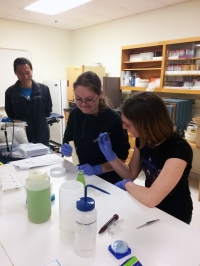Every summer, Oklahomans visit local lakes to swim, fish, boat and enjoy nature with friends and family. Researchers from the University of Oklahoma are tracking data that show Oklahoma lakes, as well as many others around the globe, may be less hospitable than we assume for some of those popular pastimes.
Dave Hambright, a Regents’ Professor of Biology in the College of Arts and Sciences and a member of the Geographical Ecology Group, represents OU in a worldwide consortium of nearly 900 researchers from 62 countries in the Global Lake Ecological Observatory Network. Hambright said the consortium enables its members to share information and data more easily to help scientists understand, predict and communicate the effects of global climate change on freshwater lakes.
In a series of recent papers published in Nature, Nature Climate Change and Scientific Reports, several GLEON working groups in which Hambright collaborates, each consisting of approximately 40 to 60 researchers, have demonstrated that lakes around the world are getting warmer and losing oxygen at alarming rates.
“We’re seeing lake temperates rise at ~0.37°C per decade, and losing oxygen at ~0.12 mg/L per decade, rates that are alarmingly three to nine times faster than rates observed in the world’s oceans,” Hambright said.
Hambright, working with Oklahoma state and municipal agencies, supplied long-term data, spanning up to four decades, on temperature, dissolved oxygen and nutrients in five Oklahoma lakes: Texoma, Thunderbird, Grand, Eucha and Spavinaw, that reveal similar patterns.




